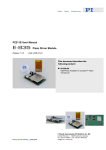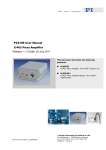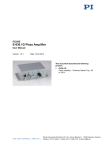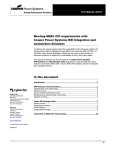Download User Manual PZ199E - Physik Instrumente
Transcript
PZ199E User Manual E-413 Release: 1.0.2 Piezo Amplifier Date: 2008-01-18 This document describes the following product(s): E-413.00 Piezo Amplifier for PICA™ Shear Actuators, -250 to +250 V, Bench-Top E-413.OE Piezo Amplifier for PICA™ Shear Actuators, -250 to +250 V, OEM Module E-413.D2 Piezo Amplifier for DuraAct™ Piezoceramic Transducers, -100 to +400 V * © Physik Instrumente (PI) GmbH & Co. KG Auf der Römerstr. 1 ⋅ 76228 Karlsruhe, Germany Tel. +49-721-4846-0 ⋅ Fax: +49-721-4846-299 [email protected] ⋅ www.pi.ws Physik Instrumente (PI) GmbH & Co. KG is the owner of the following company names and trademarks: PI® , Hyperbit™ (U.S. Patent 6,950,050) The following designations are protected company names or registered trademarks of third parties: Windows®, LabVIEW™ Copyright 1999–2008 by Physik Instrumente (PI) GmbH & Co. KG, Karlsruhe, Germany. The text, photographs and drawings in this manual enjoy copyright protection. With regard thereto, Physik Instrumente (PI) GmbH & Co. KG reserves all rights. Use of said text, photographs and drawings is permitted only in part and only upon citation of the source First printing 2008-01-18 Document Number PZ199E, Release 1.0.2 E-413_User_PZ199E102.doc This manual has been provided for information only and product specifications are subject to change without notice. About This Document Users of This Manual This manual is designed to help the reader to install and operate the E-413 Piezo Amplifier. It assumes that the reader has a fundamental understanding of basic servo systems, as well as motion control concepts, piezoelectric drives and applicable safety procedures. The manual describes the physical specifications and dimensions of the E-413 Piezo Amplifier as well as the installation procedures which are required to put the associated motion system into operation. This document is available as PDF file. Updated releases are available for download from www.pi.ws or by email: contact your Physik Instrumente Sales Engineer or write [email protected]. Conventions The notes and symbols used in this manual have the following meanings: DANGER Indicates the presence of high voltage (> 50 V). Calls attention to a procedure, practice or condition which, if not correctly performed or adhered to, could result in injury or death. WARNING Calls attention to a procedure, practice or condition which, if not correctly performed or adhered to, could result in injury or death. CAUTION Calls attention to a procedure, practice, or condition which, if not correctly performed or adhered to, could result in damage to equipment. NOTE Provides additional information or application hints. The hardware components which might be delivered with E-413 Piezo Amplifiers are described in their own manuals. Updated releases are available for download from www.pi.ws or by email: contact your Physik Instrumente representative or write [email protected]. ! Contents 1 Introduction 1.1 1.2 1.3 1.4 1.5 2 Product Description ....................................................................2 Prescribed Use ...........................................................................3 Safety Precautions .....................................................................4 Model Survey .............................................................................5 Contents of Delivery ...................................................................5 Operation 2.1 32-Pin Main Connector .............................................................. 8 System Connection Summary.................................................... 9 Start-Up ...................................................................................... 9 Monitoring the Output Voltage ................................................. 10 E-413.00 Benchtop...................................................................10 2.2.1 2.2.2 2.2.3 2.3 7 E-413.OE & E-413.D2 OEM Amplifier Modules .........................8 2.1.1 2.1.2 2.1.3 2.1.4 2.2 2 Front and Rear Panel Elements ............................................... 11 Start-Up .................................................................................... 11 E-750.PS Power Supply........................................................... 12 Modes of Operation ..................................................................13 2.3.1 External Analog Signal Source ................................................ 13 2.3.2 OEM Modules only: External DC-Offset Potentiometer ........... 13 2.3.3 OEM Modules only: Combining External Signal Source and DC Offset ..................................................................................... 13 2.3.4 Adjusting the Control Signal ..................................................... 13 2.3.5 Computer Control & Hyperbit™ ............................................... 15 3 Download of the GCS LabVIEW Driver Set for Analog Controllers 16 4 Old Equipment Disposal 17 5 Technical Data 18 5.1 5.2 5.3 5.4 Specifications ...........................................................................18 Operating Limits .......................................................................19 Block Diagram ..........................................................................19 Pin Assignments ......................................................................20 5.4.1 5.4.2 E-413.00 HV-Connector ........................................................... 20 E-413.00 3-Pin Power-In Connector ........................................ 20 Introduction 1 Introduction 1.1 Product Description Fig. 1: OEM amplifier module E-413.D2 for piezoceramic DuraAct™ patch transducers The E-413 is a stand-alone amplifier for bipolar PZTs. Three versions are available: the E-413.00 (bench-top), the E-413.OE OEM version and the E-413.D2 for DuraAct™ patch transducers. The first two can output and sink peak currents of 100 mA in a voltage range of -250 to +250 V, corresponding to the standard range of PI’s PICA™ Shear piezo actuators . The E-413.D2 is designed for driving P-876 DuraAct piezoelectric patch transducers; it offers a peak output power of 50 W with an operating voltage range of -100 to +400 V. Open-Loop Operation E-413 piezo amplifier modules provide precision control for piezo shear and bender actuators, both in static and dynamic operation. The output voltage is determined by an analog signal at the control input, combined with an optional DC-offset (external potentiometer not included), amplified by factor 50. www.pi.ws E-413 PZ199E Release 1.0.2 Page 2 Introduction Fig. 2: E-413.OE OEM amplifier module (with heat sink) for PICA™ Shear piezo actuators Fig. 3: E-413.00 bench-top piezo amplifier for PICA™ Shear actuators 1.2 Prescribed Use Based on their design and realization, the E-413 Piezo Amplifiers are intended to drive capacitive loads, in the present case, piezoceramic actuators. The E-413 must not be used for applications other than stated in this manual, especially not for driving ohmic (resistive) or inductive loads. Observe the safety precautions given in this User Manual. www.pi.ws E-413 PZ199E Release 1.0.2 Page 3 Introduction E-413s conform to Measurement Category I (CAT I) and may not be used for Measurement Categories II, III or IV. Other use of the device (i.e. operation other than instructed in this Manual) may affect the safeguards provided. E-413s meet the following minimum specifications for operation * : Indoor use only Altitude up to 2000 m Ambient temperature from 5°C to 40°C Relative humidity up to 80% for temperatures up to 31°C, decreasing linearly to 50% relative humidity at 40°C Line voltage fluctuations of up to ±10% of the line voltage Transient overvoltages as typical for public power supply Note: The nominal level of the transient overvoltage is the standing surge voltage according to the overvoltage category II (IEC 60364-4-443). 1.3 Degree of pollution: 2 Safety Precautions DANGER Read This Before Operation: E-413 modules are OEM amplifiers generating HIGH VOLTAGES for driving shear and / or bender actuators that require bipolar supply voltage. The output power may cause serious injuries. All work done with and on the modules described here requires adequate knowledge and training in handling High Voltages. Be sure to connect pin 32a/c to a Protective Ground! * Any more stringent specifications in the Technical Data table, p. 18 are, of course, also met. www.pi.ws E-413 PZ199E Release 1.0.2 Page 4 Introduction CAUTION—Overheating ! The high voltage output of the E-413 will be deactivated automatically if the hardware temperature is out of range (> 75 °C). After a cooling-down period, at a hardware temperature of 60 °C, the high voltage output is reactivated automatically. To avoid overheating, reduce the operating frequency and/or the load and/or the ambient temperature. 1.4 Model Survey E-413 amplifiers are designed as EURO-board plug-in modules which can be installed in a desktop chassis as well as in a 19"rack-mount chassis. The following different models are available: 1.5 E-413.00 Piezo Amplifier for PICA™ Shear Actuators, -250 to +250 V, Bench Top E-413.OE Piezo Amplifier for PICA™ Shear Actuators, -250 to +250 V, OEM Module E-413.D2 Piezo Amplifier for DuraAct™ Patch Transducers, -100 to +400 V Contents of Delivery Unpack the E-413 Piezo Amplifier with care. Compare the contents against the items ordered and against the packing slip. The following items are included: E-413 PZ199E E500T0011 www.pi.ws Amplifier as ordered User Manual in printed form (this document) Technical Note for Analog Drivers E-413 PZ199E Release 1.0.2 Page 5 Introduction For E-413.00: E-692.SMB Cable for control signal input, SMB to BNC, length 1.5 m E-750.PS Wide-range power supply, 24V/30W with interchangeable prong sets K030B0266 Cable for piezo connection, sub-D-mix connector, 2 solderable leads: red: PZT voltage, black: PGND, housing: cable shield, for protective ground For E-413.OE and E-413.D2: 588 Solderable socket matching the 32-pin main connector, designed for installation completely inside the user housing. Because the connector standard includes types with more pins, the 32 pins used are all carry even number designations and are in rows “a” and “c”. Fig. 4: Included connector, PI Part No. 588 www.pi.ws E-413 PZ199E Release 1.0.2 Page 6 Operation 2 Operation WARNING E-413s need to be installed in such a way that they can quickly and easily be separated from the supply voltage. DANGER Read This Before Operation: E-413 modules are OEM amplifiers generating HIGH VOLTAGES. The output power may cause serious injuries. When working with these devices or using PZT products from other manufacturers we strongly advise you to follow the General Accident Prevention Regulations. All work done with and on the modules described here requires adequate knowledge and training in handling High Voltages. Be sure to connect pin 32a/c to a Protective Ground! CAUTION—Overheating ! The high voltage output of the E-413 will be deactivated automatically if the hardware temperature is out of range (> 75 °C). After a cooling-down period, at a hardware temperature of 60 °C, the high voltage output is reactivated automatically. To avoid overheating, reduce the operating frequency and/or the load and/or the ambient temperature. NOTE - When powering up the module, the DC-DC converter needs a peak current of about 1.5 A to start oscillating. The power supply should have a buffer capacitor, or the external power supply should be able to supply the 1.5 A for at least 1 second. www.pi.ws E-413 PZ199E Release 1.0.2 Page 7 Operation - The inputs and outputs of the DC-DC converter are not connected internally. Using a unipolar power supply, we recommend connecting the negative supply at pin 18a,c with the GND at pin 20a,c. This provides a defined GND level and helps to minimize noise. 2.1 E-413.OE & E-413.D2 OEM Amplifier Modules 2.1.1 32-Pin Main Connector All inputs and outputs are available on the main connector. Because the DIN 41612 connector standard includes types with more pins, the 32 pins of the “D” version all carry even number designations and are in rows “a” and “c”. Function Function PZT output a 2 c PZT output PZT GND a 4 c PZT GND nc a 6 c nc Monitor PZT out (1000:1) a 8 c Control out Control In a 10 c Amplifier In 10 kOhm pot (-10 V) a 12 c Pot wiper 10 kOhm pot (GND) & a GND 14 c 10 kOhm pot (GND) & GND +VCC supply, +24 V a 16 c +VCC supply, +24 V -VCC supply, 0 V a 18 c -VCC supply, 0 V (connect to 20c for minimum noise) AGND a 20 c AGND nc a 22 c AGND nc a 24 c nc nc a 26 c Sync Input TTL Signal, 200kHz nc a 28 c nc nc a 30 c nc Protective GND a 32 c Protective GND nc = not connected 2.1.2 System Connection Summary For operation, at least the following elements must be connected: www.pi.ws E-413 PZ199E Release 1.0.2 Page 8 Operation Main Connector Supply power, 24 VDC + 16a&c; – 18a&c PZT out 2 a&c PZT GND 4a&c Control out to Amplifier In 8c to 10c (e.g. short these pins) Control In* 10a & 14c DC-offset pot* 12a & c & 14a GND 22c, 20a&c, 14a&c Protective GND 32a&c *The DC-offset pot may be missing or the Control In signal shorted, but not both. CAUTION ! If no external potentiometer is connected, pin 12c and 14c on the main connector (E-413.OE & E-413.D2) must be shorted. 2.1.3 Start-Up On the main board of the E-413 modules a DC-DC converter is installed with a 23 to 26 VDC input voltage range. The converter generates -270 and +270 V (E-413.OE) or -110 and +430V (E413.D2) for the power amplifier. www.pi.ws 1 Connect pin 8c (control out) and pin 10c (amplifier in). 2 Optionally connect an external 10 k-ohm potentiometer to 12a, 12c and 14a. Turn it to zero offset (CCW) to avoid jumps of the mechanics when the amplifier is powered on. 3 Supply the board with the 24 VDC power at pins 16a/c and 18a/c. The green power-on LED on the base of the board should light up. Check the output voltage between main connector pins 2a/c and 4a/c without an actuator connected. The internal power supply has a soft start, it takes a few seconds (10 to 20 s) to get a stable output voltage. In this time the Control Input should be 0V. 4 If you have connected the optional external potentiometer to offset the control input range, then it can be used to check the output voltage. Varying the offset should make E-413 PZ199E Release 1.0.2 Page 9 Operation the output vary from 0 to +250 V (E-413.OE) or 0 to +400 V (E-413.D2) (see Sections 2.3.2, p.13 and 2.3.4, p.13) 5 If no external potentiometer is connected, drive the control input (pin 10a, 14c) with a control voltage in the range of -5 to +5 V (E-413.OE) or -2 to +8 V (E-413.D2). The corresponding output ranges should be -250 to +250 V and -100 to +400 V respectively (see Section 2.3.4, p.13 for possible modifications) Most dynamic applications require the power amplifier to deliver a short peak current higher than an average value. Because of the limited power of the transistors, this peak is limited to about 5 ms in length. After this time the current decreases to the average value. 2.1.4 Monitoring the Output Voltage The PZT drive voltage is proportional to the analog signal input in combination with the position of the DC offset potentiometer, if installed. The PZT output voltage can be monitored either directly (in parallel with the PZT) or on main connector pin 8a, which carries a high-impedance output of 1/1000th the voltage of the PZT. 2.2 E-413.00 Benchtop CAUTION Do not cover the ventilation slots on the top or front of the E-413.00. The device needs to be installed horizontally with 3 cm air circulation clearance. Vertical mounting prevents internal convection. Insufficient air flow will cause overheating and premature failure. www.pi.ws E-413 PZ199E Release 1.0.2 Page 10 ! Operation 2.2.1 Front and Rear Panel Elements Fig. 5: E-413.00 front view with power LED The green front panel LED indicates that the module is powered up and in operation. All connections are located on the rear panel. Fig. 6: E-413.00 rear panel Power In 3-pin socket, +24 V unipolar supply voltage, provided by E-750.PS power supply (20 to 30 V DC, 1.25 A, 5 A / 0.1 ms), see p. 20 Control Input SMB socket, -5 to +5 V Protective ground Stud with nut and lock washer PZT Out Sub-D mix, p.20 2.2.2 Start-Up www.pi.ws 1 Make sure that the E-413.00 is not connected to power. 2 Connect the piezo actuator to the E-413.00 PZT out socket using the K030B0266 cable which comes with the E-413 PZ199E Release 1.0.2 Page 11 Operation amplifier. Note: PI series of shear actuators (P-111 to P-151) have red leads for high voltage and black leads for GND connection. The cable has to be soldered to the piezo actuator. Be careful to solder the red cable lead to PZTvoltage, and the black cable lead to GND. 3 Connect suitable analog signal sources to the Control Input SMB socket using the E-692.SMB cables which come with the E-413.00. Do not yet apply any voltage to these lines. The E-413.00 accepts control input signals from -5 V to +5 V. 4 Connect the Power In socket on the amplifier rear panel to the E-750.PS power supply, which comes with the system. The amplifier is powered on immediately when you plug in the power supply. Now the green Power LED on the front panel lights up. The internal power supply has a soft start, it takes a few seconds (10 to 20 s) to get a stable output voltage. In this time the control Input should be 0V. 5 Command motion by applying an external analog control signal in the appropriate input range 2.2.3 E-750.PS Power Supply If necessary, slide out and replace the interchangeable prongs on the power supply with the set that fits the power outlets you plan to use (see ). The amplifier is powered on immediately when you connect the power supply to the line voltage. Fig. 7: Interchanging prongs: no tools required www.pi.ws E-413 PZ199E Release 1.0.2 Page 12 Operation 2.3 Modes of Operation All units are operated as simple power amplifiers, i.e. in voltagecontrolled mode, where the PZT output voltage depends directly on the input control voltage and the DC offset, if any. This is also known as open-loop or servo-off operation. CAUTION ! If no external potentiometer is connected, pin 12c and 14c on the main connector (E-413.OE & E-413.D2) must be shorted. 2.3.1 External Analog Signal Source For external operation, the output voltage is controlled by an external DC signal of -5 to +5 V (E-413.00 and E-413.OE) or -2 to +8 V (E-413.D2). See section 2.3.5, p.15, for information on PI support of external operation with a DAC card in a PC. 2.3.2 OEM Modules only: External DC-Offset Potentiometer In manual operation, the target voltage is controlled manually with an external 10 kΩ DC-offset potentiometer (not included). This potentiometer must be connected to pin 12a (CW), 14a (CCW), and, the wiper to pin 12c. 2.3.3 OEM Modules only: Combining External Signal Source and DC Offset For external operation with offset, the offset potentiometer (or equivalent) is attached and an external DC signal is used on Control IN. The position of the potentiometer (minus 1 times the wiper voltage) is added to the analog control input signal. The result must be in the -5 to +5 V (E-413.OE) or -2 to +8 V (E413.D2) range. 2.3.4 Adjusting the Control Signal DANGER—HAZARDOUS VOLTAGE Disconnect unit from power before adjusting the jumper settings. Observe all precautions against static charge buildup. This procedure should be carried out by authorized, qualified personnel only. Attention: opening the E-413.00 case is required. www.pi.ws E-413 PZ199E Release 1.0.2 Page 13 Operation Due to the constant gain of 50, the range of the control signal (Amplifier IN) is 1/50 of the Output Voltage Range. The following adjustments can be made to make the full output voltage range available: For E-413.00: First unscrew the 8 attachment screws (4 on top, 2 on the front, 2 on the rear) and remove the cover. Invert the Control Out signal (pin 8c) with Jumper S1. 1-2 (both), default setting, see figure below: No inversion 2-3 (both): inversion Fig. 8: E-413 adjustment elements. Default jumper settings OEM Modules only: Shift with DC Offset: Use the optional DC-offset potentiometer or equivalent to add a constant to the analog Control In signal. Jumper J1 sets the ranges for the DC-potentiometer (see section 5.3, p.19) : 1-2 (default, see figure above): half range. Turning the pot adds 0 to 10 V to Control In. 2-3: full range. Turning the pot adds -5 to +5 V to Control In. NOTE With the jumper J1 set to position 2-3 the offset potentiometer offers an input voltage from -5 to +5 V. This setting is therefore not recommended for E-413.D2, since, without an analog voltage applied, the amplifier output is limited to +250 V. www.pi.ws E-413 PZ199E Release 1.0.2 Page 14 Operation 2.3.5 Computer Control & Hyperbit™ Computer control of an E-413 can be realized using a DAC-board in a PC to generate the analog input signal. PI offers a LabVIEW™ driver set which can be used with certain D/A boards. This driver set is compatible with the PI General Command Set (GCS) LabVIEW driver set available for all newer controllers from PI. The Analog Controller LabVIEW™ Driver (E-500.ACD) is free of charge, but requires the LabVIEW™ environment from National Instruments for operation. In addition, PI’s patented Hyperbit™ technology for providing position resolution higher than that of the D/A board is available for purchase as an option (E-500.HCD). The PI Analog Controller and Hyperbit™ drivers support all D/A converter boards from National Instruments that are compatible with DAQmx8.3. LabVIEW™ compatibility is given from version 7.1 upwards. Instructions for downloading the Analog Controller drivers is given in the included E500T0011 Technical Note . www.pi.ws E-413 PZ199E Release 1.0.2 Page 15 Download of the GCS LabVIEW Driver Set for Analog Controllers 3 Download of the GCS LabVIEW Driver Set for Analog Controllers Updated releases of GCS LabVIEW drivers for analog controllers from PI and the corresponding manuals are available for download at www.pi.ws. While the manuals are freely accessible, you need a password for the software download. This password is provided in a Technical Note delivered with the controller (E500T0011). To download from the PI Website, proceed as follows: www.pi.ws 1 On the www.pi.ws front page, click on "Download/Support" in the "Service" section on the left 2 On the "Download/Support" page, click on "Manuals and Software" 3 On the "PI Download Server" page, enter the Username and the Password which are provided in the separate Technical Note and click on "Login" 4 Click on "Download" in the navigation bar across the top 5 Click on the "E Piezo Drivers & Nanopositioning" category 6 Click on "E-500" 7 "Release" includes the software, "Documents" contains the latest manuals (which may be newer than those in “Release”!) 8 Click the "Download" button E-413 PZ199E Release 1.0.2 Page 16 Old Equipment Disposal 4 Old Equipment Disposal In accordance with EU directive 2002 / 96 / EC (WEEE), as of 13 August 2005, electrical and electronic equipment may not be disposed of in the member states of the EU mixed with other wastes. To meet the manufacturer’s product responsibility with regard to this product, Physik Instrumente (PI) GmbH & Co. KG will ensure environmentally correct disposal of old PI equipment that was first put into circulation after 13 August 2005, free of charge. If you have such old equipment from PI, you can send it to the following address postage-free: Physik Instrumente (PI) GmbH & Co. KG Auf der Römerstr. 1 76228 Karlsruhe, Germany www.pi.ws E-413 PZ199E Release 1.0.2 Page 17 Technical Data 5 Technical Data 5.1 Specifications Models E-413.00 E-413.OE E-413.D2 Function Power amplifier for PICA™ Shear piezo actuators, bench-top Power amplifier for PICA™ Shear piezo actuators, OEM module Power amplifier for piezoelectric DuraAct patch transducers, OEM module Output voltage range -250 to 250 V -250 to 250 V -100 to 400 V Peak output power 50 W 50 W 50 W Average output power 12 W 12 W 6W Peak current (< 5ms) 100 mA 100 mA 100 mA Average current 24 mA 24 mA 12 mA Current limitation Short-circuit-proof Short-circuit-proof Short-circuit-proof Voltage gain 50 ±0.1 50 ±0.1 50 ±0.1 Ripple, noise, <10 kHz 100 mV P-P @100 nF 100 mV P-P @100 nF 100 mV P-P @100 nF Amplifier resolution <10 mV < 10 mV <10 mV Input impedance 100 kΩ 100 kΩ 100 kΩ Piezo connector Conec Sub-D 5W1 with HV (rear) DIN 41612, 32-pin (rear) DIN 41612, 32-pin (rear) Control input voltage SMB connector (rear) DIN 41612, 32-pin (rear) DIN 41612, 32-pin (rear) Operating temperature range +5°C to +50°C (10% derated over 40°C) +5°C to +50°C (10% derated over 40°C) +5°C to +50°C (10% derated over 40°C) Dimensions 220 x 105 x 54 mm 14HP/3HU 160 x 100 x 57 mm 7HP/3HU 160 x 100 x 39 mm Mass 1.14 kg 0.8 kg 0.4 kg Operating voltage 24 V / 2 A 24 V / 2 A 24 V / 1 A Power consumption 48 W 48 W 24 W Amplifier Interface and operation Miscellaneous www.pi.ws E-413 PZ199E Release 1.0.2 Page 18 Technical Data 5.2 Operating Limits Fig. 9: E-413 open-loop frequency response with various PZT loads. Values shown are capacitance in nF 5.3 Block Diagram The basic circuit design of the amplifier modules is shown in the drawing below. Input signals at main connector pin 10c and the signal from the external DC-offset potentiometer are combined in the preamplifier stage. The resultant signal will be used as input for the amplifier. www.pi.ws E-413 PZ199E Release 1.0.2 Page 19 Technical Data Fig. 10: E-413 wiring. Pin numbers for E-413.OE and E-413.D2 are given in the drawing (see section 2.1.1, p.8, for pin assignments). Jumper positions are not shown 5.4 Pin Assignments 5.4.1 E-413.00 HV-Connector Center: HV Output, recessed, Outer pins: GND Fig. 11: Conec 5W1 5.4.2 E-413.00 3-Pin Power-In Connector Type: Switchcraft Connector Pin 1 Pin 2 Pin 3 www.pi.ws Function GND or 0V +24V (+23 - +26V) Not used E-413 PZ199E Release 1.0.2 Page 20



































